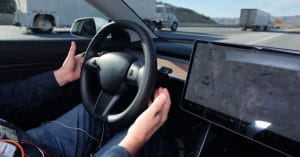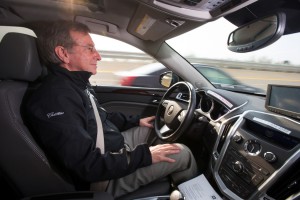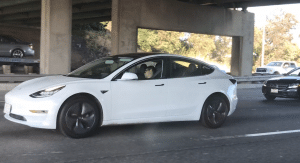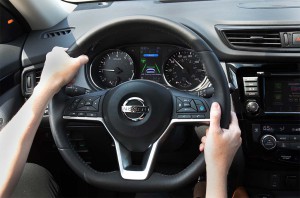
A new AAA study shows that the name of an advanced driver assistance system shapes the driver’s perception of its abilities.
Advanced driver assistance systems, or ADAS, often mean different things to different drivers and a new study shows that the expectations of what’s expected can be summed up using an old cliche: What’s in a name?
According to a new study from AAA, the name of the ADAS system means, well, everything. It sets the tone for what drivers expect from the system and the results of the study aren’t likely to make Tesla executives very happy.
Researchers at the AAA Foundation for Traffic Safety found consumers who get information about these systems focusing on their convenience and capabilities while minimizing limitations tend to believe the technology possesses more capabilities than it actually does.
(Tesla loses Autopilot court case in Germany.)
Unsurprisingly, more balanced information, particularly the name, lowers the expectations of the system’s abilities. As a result of the study, AAA warns that a false sense of system capabilities created by marketing campaigns can lead to dangerous scenarios on the road.

Cadillac’s Super Cruise semi-autonomous system is now available with an eye toward making it fully self-driving in the future.
“Based on data collected from our research, subtle differences in tone and emphasis significantly influenced people’s understanding of the technology and their expectations of its capability,” said Dr. David Yang, executive director of the AAA Foundation for Traffic Safety. “These systems assist the driver and take some of the stress out of driving, but they don’t eliminate the need for drivers to pay attention.”
Well, AAA decided to put that theory to the test. In a 90-person study using the same system, half were told the system’s was named “AutonoDrive” and were given an upbeat training that emphasized the system’s capabilities and driver convenience. The other half were told it was named “DriveAssist,” and their training focused on the system’s limitations and driver responsibility. Participants trained on AutonoDrive came away with greater confidence — and in some cases, overconfidence — in the system.
After completing the training and driving the test vehicle, 42% of the participants using AutonoDrive, said its name made the system sound more capable than it is, while only 11% of DriveAssist users felt the same. Some of the specifics include:
- 62% felt AutonoDrive would make them feel more comfortable eating while driving compared with just 27% of DriveAssist “users”
- 45% believed AutonoDrive would make them feel more comfortable using a handheld cell phone versus just 13% with DriveAssist
- 45% thought AutonoDrive could take action to avoid a collision when a vehicle directly to the side begins steering into it to change lanes compared with just 4% of DriveAssist users
- 56% of AutonoDrive users thought the it could automatically reduce speed on a tight cu
rve without the driver doing anything versus just 27% of Drive Assist participants
“From our research, it’s clear that education and training can influence users’ expectations, how they will interact with and their behaviors when using new vehicle technologies,” added Yang.
(Advocacy groups attack Tesla’s use of Autopilot — again.)
It’s this very premise that critics of Tesla’s Autopilot semi-autonomous technology have been touting for years. In fact, just recently a German court supported that position in a recent ruling, saying that using the name in advertising is misleading to customers.
The Munich Regional Court ruled Tesla can no longer advertise its semi-autonomous driving technology using the name “Autopilot.” While the name could conjure up images of a driver pressing a button and letting the car do all the work, the court’s ruling seemed to hinge on a claim that accompanied the word.
In the ads, the EV maker said their Autopilot-equipped vehicles have “full potential for autonomous driving.” The judges also said the company wrongly promoted its cars as being able to self-navigate in cities by the end of 2019.

Reddit user MiloWee posted video of this Tesla Model 3 driver apparently asleep behind the wheel in traffic in Los Angeles.
To be fair, Tesla isn’t alone when it comes to suggestive names. Potential consumer misunderstandings of new vehicle technology need to be addressed. In a previous AAA survey, 40% of Americans said they expect active driving assistance systems, with names like Autopilot and ProPilot, to have the ability to drive the car by itself.
“Automakers are in the business of selling vehicles,” said Jake Nelson, AAA director of traffic safety advocacy and research. “Understandably, they will emphasize convenience and system capabilities in their marketing campaigns.
“But, their marketing campaigns, materials and consumer information should not mislead motorists. Words matter. We can do better by taking care to be more realistic in setting expectations for consumers such that the sale of a new vehicle does not come at the expense of safety.”
(Study shows motorists confused by high-tech features like Autopilot, Super Cruise, ProPilot.)
Tesla CEO Elon Musk has long maintained the company has consistently told drivers at every turn they must keep their hands on the wheel and remain alert to the warning systems in the vehicle. Despite this, the internet – particularly YouTube – is filled with videos of drivers cheating the warning system while doing everything from simply taking in the scenery to napping to having sex.

